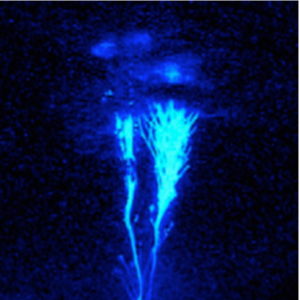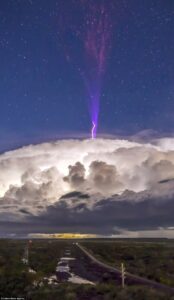Originally published in 2007, this UBtheNEWS Report is of particular interest because of the way that it also relates to efforts by Matthew Block to identify human source material for The Urantia Book. In this instance, the source he identifies was not published until 1942, which is eight years after The Urantia Book states the text was completed and the same year that galley proofs were being reviewed. While the parallels are intriguing, the dissimilarities are at the heart of the issue. With new research continuing to support the revelatory information in The Urantia Book, this topic remains one of the most intriguing of all the UBtheNEWS Reports.
Inner Ionosphere Report Summary:

Blue jets shooting up out of storm clouds.
In discussing earth’s atmosphere, The Urantia Book states the following, “The lower five or six miles of the earth’s atmosphere is the troposphere; this is the region of winds and air currents which provide weather phenomena. Above this region is the inner ionosphere and next above is the stratosphere.” Urantia Book enthusiasts and critics alike have long considered this statement to be a mistake because the longstanding understanding of the earth’s atmosphere has been that the ionosphere exists above the stratosphere.
However, in the late 1980’s and early 1990’s, over thirty years after The Urantia Book‘s publication, observation of “blue jets” were conclusively documented and accepted as an atmospheric condition. Notwithstanding that this phenomenon is still not well understood, what has been learned about blue jets indicates that there must be an ionospheric layer below the stratosphere. Blue jets form above thunderclouds and often reach a height of about 25 miles above sea level. The long-recognized ionosphere, which exists above the stratosphere, begins at around 30 miles above sea level.
Calculations based on videos taken of blue jets, as well as other associated research, indicate that the ionic condition necessary to create their luminescent quality could not have its source in the thunderclouds over which they occur.
Read a pdf of the original UBtheNEWS presentation of this report.
 Updates:
Updates:
Plain Language Summary
It has been a matter of interest, if electromagnetic fluctuations caused by lightning can propagate from the lower atmosphere higher into the ionosphere, which is an ionized and electrically conducting medium. This process requires conversion of the electromagnetic perturbation propagating in the neutral atmosphere into an ionospheric plasma wave, which for ultralow frequencies (ULF) can attenuate strongly the wave amplitude. The attenuation is considered to be rather significant, thus one could argue that it is virtually not possible to observe the ionospheric magnetic field perturbations caused by lightning using currently available satellite magnetometers.
There are many remote observations of lightning and direct satellite measurements of ionospheric magnetic field fluctuations, that can be analyzed searching for a possible link between the two phenomena. Using Swarm satellite measurements and two types of lightning observations, we provide an evidence that lightning generate electromagnetic perturbations that propagate into the upper ionosphere and can be measured with magnetometers onboard low-Earth orbit satellites, for example, by the Swarm constellation. We reveal links between lightning and ionospheric wave properties, that suggest a real causality relationship between the two phenomena. To our knowledge, this is the first direct experimental confirmation of such a relation in the ULF range.
Introduction
The term ‘sporadic E (Es)’ was first used to describe the abnormal nocturnal E layer at nearly 105 km in the early 1930s when the term ‘ionosphere’ was introduced by Watson–Watt at the UK’s Radio Research Station to designate the ionized layers in the Earth’s upper atmosphere. These previous records suggest that the occurrence of Es layers (nocturnal E-region ionization) is correlated with not only the occurrence of magnetic storms but also the occurrence of thunderstorms. An enhancement of the ionospheric Es layer due to lightning was later reported by a statistical superposed epoch analysis (SEA) and confirmed by following studies. The time delay between thunderstorm activities and the response of Es layers is associated with the tidal periodicities in the Es variability. For the mid-latitude, the most widely accepted mechanism for the production of Es layers is the wind shear theory. Patches of ionization within Es layers form as a result of the vertical ion convergence driven by vertical shears in the zonal neutral wind (a westward wind increasing with altitude) and meridional neutral wind (a northward wind increasing with altitude for the Northern Hemisphere, or a southward wind increasing with altitude in the Southern Hemisphere). The wind shear theory indicates that the formation of Es layers should be inhibited on the magnetic equator, because the ions fail to converge vertically into a layer when the magnetic field is horizontal. The equatorial Es arises from the gradient instability and is associated with the enhanced electro-jet current. Based on the expression for the vertical ion drift in wind shear theory, the vertical velocity of ions is very small when cosI ∼ 0. Here, I denotes the magnetic dip angle. So the ion-convergence mechanism does not work efficiently at high magnetic latitudes, but the vertical effects of gravity waves and electric field are very efficient in concentrating the ionization of Es layers in the central polar cap where the magnetic-field lines are approximately vertical. The wind shear theory has been confirmed by incoherent scatter radar (ISR), meteor radar, ionosonde, rocket, lidar and chemical tracer measurements, as well as the measurements and model simulations of metal ions and atoms in the mesosphere and lower thermosphere (MLT). The main problem of wind shear theory is to explain the global morphology of Es and its seasonal distribution. [Footnotes omitted.]
2005-06-09: Lightning-induced intensification of the ionospheric sporadic E layer.
Abstract
A connection between thunderstorms and the ionosphere has been hypothesized since the mid-1920s. Several mechanisms have been proposed to explain this connection, and evidence from modelling as well as various types of measurements demonstrate that lightning can interact with the lower ionosphere. It has been proposed, on the basis of a few observed events, that the ionospheric ‘sporadic E’ layer–transient, localized patches of relatively high electron density in the mid-ionosphere E layer, which significantly affect radio-wave propagation–can be modulated by thunderstorms, but a more formal statistical analysis is still needed. Here we identify a statistically significant intensification and descent in altitude of the mid-latitude sporadic E layer directly above thunderstorms. Because no ionospheric response to low-pressure systems without lightning is detected, we conclude that this localized intensification of the sporadic E layer can be attributed to lightning. We suggest that the co-location of lightning and ionospheric enhancement can be explained by either vertically propagating gravity waves that transfer energy from the site of lightning into the ionosphere, or vertical electrical discharge, or by a combination of these two mechanisms.